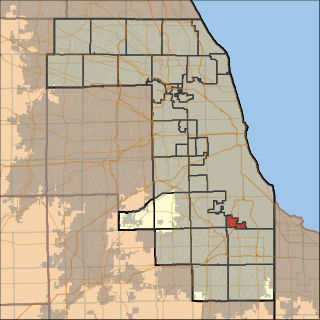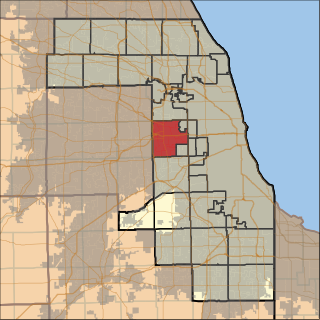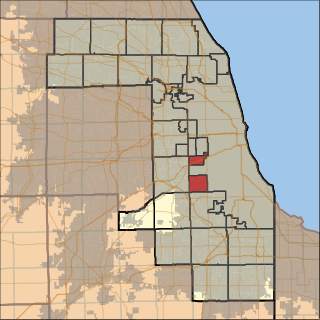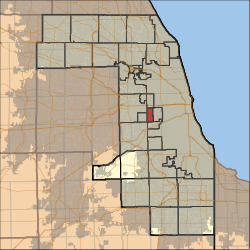
Hometown is a city in Cook County, Illinois, United States. The population was 4,343 at the 2020 census.

Stickney is a village in Cook County, Illinois, United States. The village is named for Alpheus Beede Stickney, a railroad executive who played a central role in establishing the Clearing Industrial District. Per the 2020 census, the population was 7,110. It was well known in the 1920s and early 1930s as the home for several bordellos linked to mobster Al Capone's empire.

Bremen Township is one of 29 townships in Cook County, Illinois, USA. As of the 2020 census, its population was 107,149 and it contained 42,611 housing units. It was organized in 1850 and is located southwest of Chicago in southern Cook County. An administrative office for Bremen Township is located at 16361 South Kedzie Parkway, Markham, Illinois. It is named after the State of the same name in Germany as this area was settled by primarily German settlers.

North Okaw Township is one of twelve townships in Coles County, Illinois, United States. As of the 2020 census, its population was 1,004 and it contained 366 housing units. The Kaskaskia River flows through the township. The Cook Mills Consolidated oil field is within this township. The township changed its name from Okaw Township on May 7, 1860.

Bloom Township is one of 29 townships in Cook County, Illinois, USA. As of the 2020 census, its population was 86,018 and it contained 33,964 housing units.

Calumet Township is one of 29 townships in Cook County, Illinois, United States. As of the 2020 census, its population was 18,609 and it contained 8,210 housing units.

Cicero Township is one of 29 townships in Cook County, Illinois, United States. It is coextensive with the town of Cicero. As of the 2020 census, its population was 85,268.

Lemont Township is one of 29 townships in Cook County, Illinois, USA. As of the 2020 census, its population was 22,645 and it contained 8,580 housing units.

Lyons Township is one of 29 townships in Cook County, Illinois. As of the 2020 census, its population was 115,105, with its most populous municipalities including La Grange, Justice and Summit. Lyons Township was established in 1850. The village of Lyons, almost all of which lies within the township, is often confused with it.

Oak Park Township is one of 29 townships in Cook County, Illinois and its boundaries are coterminous with the village of Oak Park. As of the 2020 census, the population was 54,583.

Proviso Township is one of 29 townships in Cook County, Illinois, United States. As of the 2020 census, its population was 151,209. It was organized in 1850 and originally named "Taylor", but shortly afterward its name was changed to make reference to the Wilmot Proviso, a contemporary piece of legislation intended to stop the spread of slavery.

River Forest Township is one of 29 townships in Cook County, Illinois. The population was 11,717 at the 2020 census. River Forest Township is coterminous with the Village of River Forest. It is one of four coterminous townships in Cook County and one of seventeen coterminous townships statewide. Like the village, the township is bounded by Harlem Avenue, North Avenue, Madison Avenue to Lathrop Avenue, to Central Avenue and back to Harlem.

Riverside Township is one of 29 townships in Cook County, Illinois, USA. As of the 2020 census, its population was 16,664.

Stickney Township is one of 29 townships in Cook County, Illinois. As of the 2020 census, its population was 41,514, with approximately 71% of that total living in the city of Burbank.

Hunter Township is one of fifteen townships in Edgar County, Illinois, USA. As of the 2020 census, its population was 232 and it contained 104 housing units. Hunter Township was formed from portions of Stratton Township and Brouilletts Creek Township on an unknown date.

Arispie Township is one of twenty-five townships in Bureau County, Illinois, USA. As of the 2020 census, its population was 763 and it contained 355 housing units.

Condit Township is a township in Champaign County, Illinois, USA. As of the 2020 census, its population was 486 and it contained 206 housing units.

East Bend Township is a township in Champaign County, Illinois, USA. As of the 2020 census, its population was 623 and it contained 261 housing units. East Bend Township was named for a meander of the Sangamon River.

Shafter Township is one of twenty townships in Fayette County, Illinois, USA. As of the 2020 census, its population was 466 and it contained 207 housing units. Shafter Township was formed out of Sharon Township in December, 1920.

Eastern Township is one of twelve townships in Franklin County, Illinois. As of the 2020 census, its population was 589 and it contained 270 housing units.























